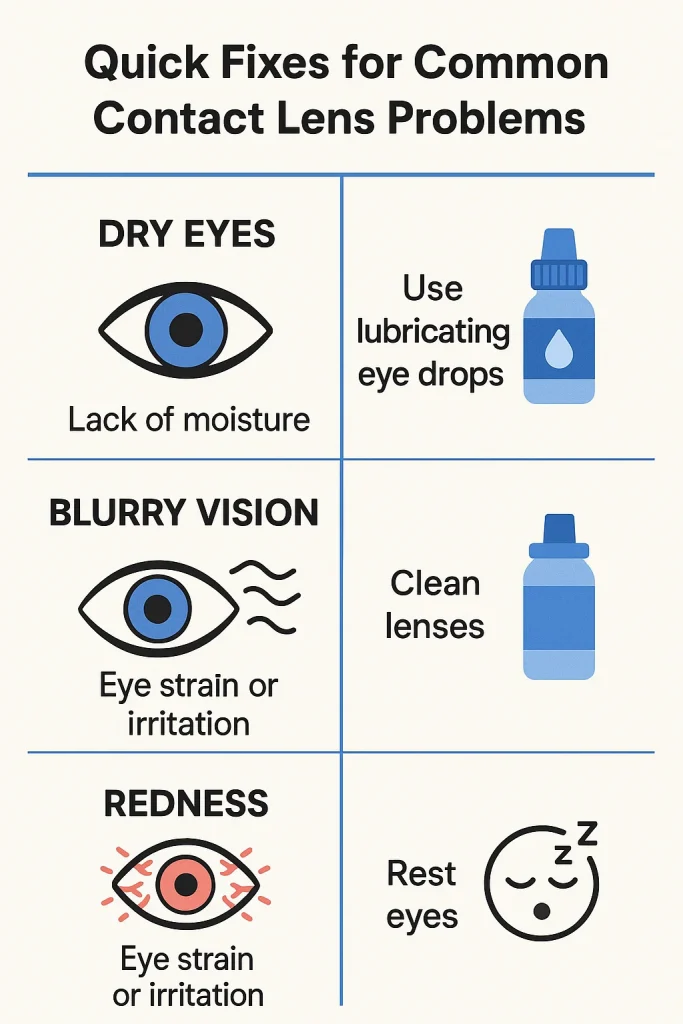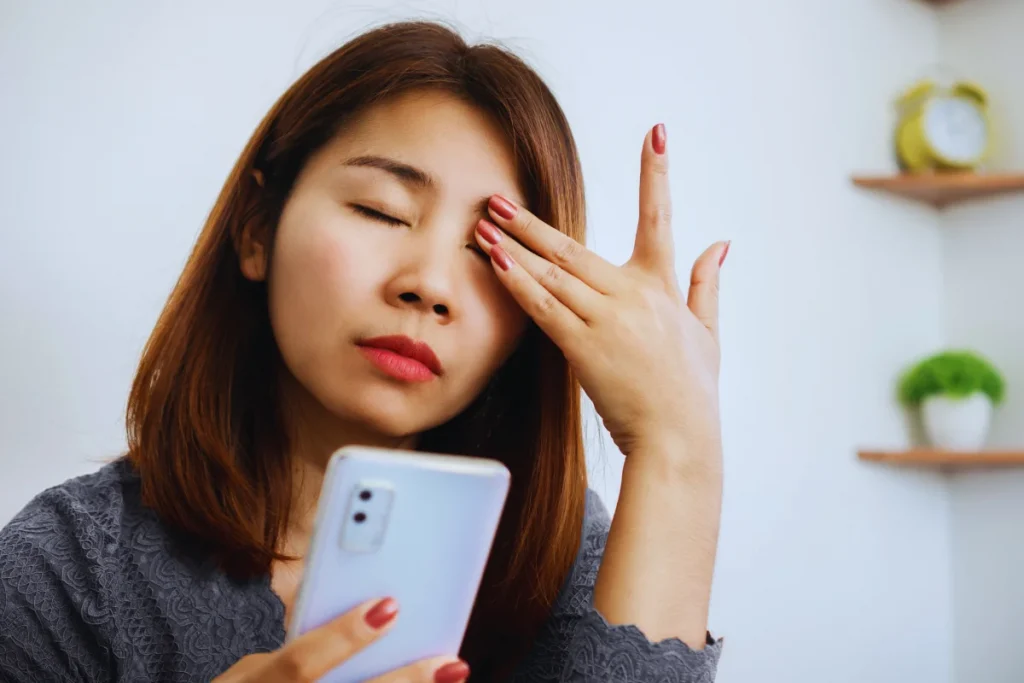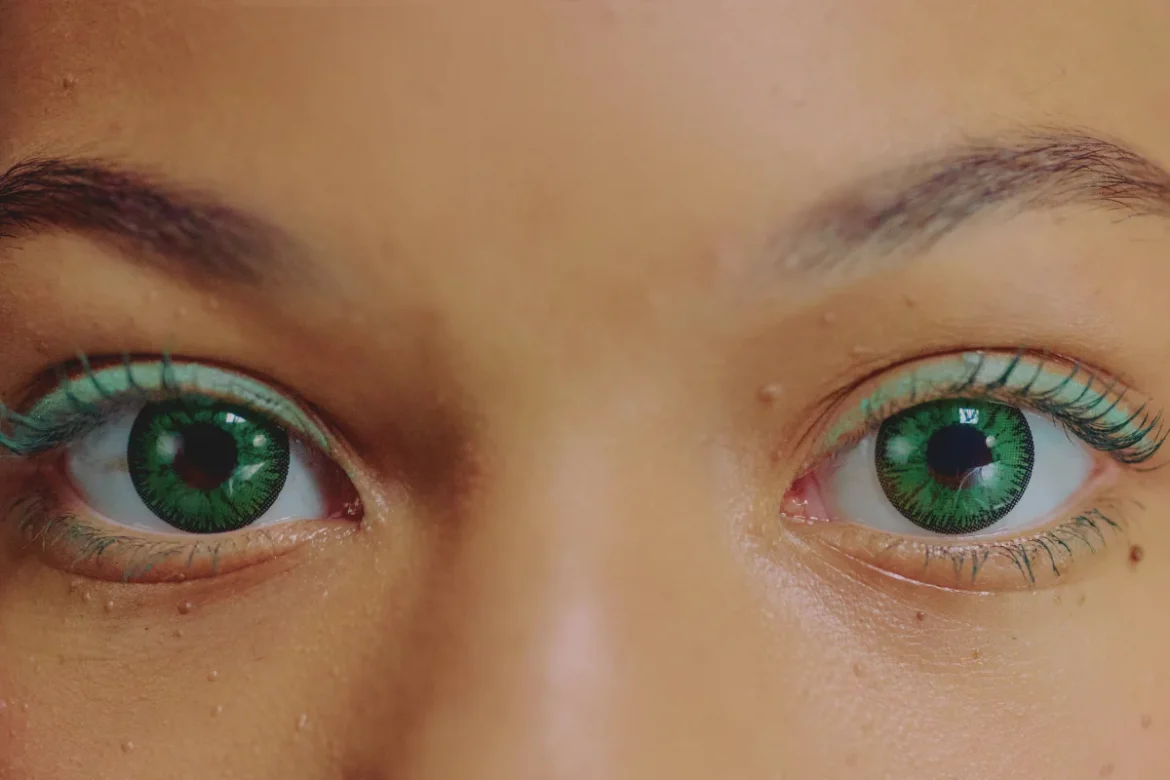Contact lenses are a popular alternative to glasses for people who want clear vision without the frames. They’re lightweight, convenient, and often provide better peripheral vision than glasses. These small lenses are placed directly on the eye and are used for both medical and cosmetic reasons.
Over the years, contact lenses have become more advanced and widely available. Many users now rely on them daily for work, social events, and active lifestyles. However, despite their benefits, wearing contact lenses comes with responsibilities. Without proper care, they can lead to discomfort and even eye health issues.
Understanding the common problems associated with contact lens use can help you prevent them. When you know what to expect and how to handle issues early, your experience becomes safer and more comfortable.
Why Contact Lens Issues Happen
Most contact lens problems start with simple mistakes.
- One of the most common causes is poor hygiene.
- Touching your lenses with dirty hands or failing to clean them properly can lead to irritation or infection.
- Another issue is not following the recommended wear time. Sleeping with lenses or wearing them longer than advised can harm your eyes.
Your environment can also affect your lenses. Dry air, smoke, allergens, or dust may cause dryness, itchiness, or discomfort while wearing lenses. In some cases, the lenses may not fit your eyes correctly or your prescription may be outdated. These issues can cause blurry vision, discomfort, or even eye strain.
Knowing why problems occur is the first step in avoiding them. Good habits, regular eye check-ups, and understanding your lens needs can go a long way in keeping your eyes healthy.
Most Common Contact Lens Problems
1. Dry Eyes
Dry eyes are one of the most common problems for contact lens wearers. You might feel constant itchiness, a burning sensation, or notice that your vision becomes blurry after wearing lenses for a few hours. These symptoms are often worse in air-conditioned rooms or after spending a long time staring at screens.
Dryness can happen for several reasons. Spending too much time on your phone or computer can cause you to blink less, which dries out your eyes. Not drinking enough water or being in dry environments also reduces natural moisture. In some cases, the lens material itself does not hold enough hydration, making dryness worse.

To ease dry eyes, try using lubricating or rewetting drops that are safe for contact lenses. These help keep your eyes moist and comfortable throughout the day. You can also ask your eye doctor about switching to lenses designed for dry eyes. These high-moisture lenses retain more hydration and are often more comfortable for longer wear.
Taking breaks from screens, staying hydrated, and following your wear schedule will also help reduce dryness and improve comfort.
2. Red or Irritated Eyes
Red or irritated eyes are another issue many contact lens users face. You may feel a scratchy or stinging sensation, and your eyes might look bloodshot. This discomfort can come from several causes, such as wearing lenses for too long, using lenses that are not properly cleaned, or having an allergic reaction to dust or pollen.
Sometimes, red eyes are just a sign of mild irritation. But in other cases, it can be more serious, like an infection or corneal inflammation. If the redness is accompanied by pain, sensitivity to light, or unusual discharge, it’s important to remove your lenses right away and see an eye doctor.
For mild irritation, taking out your lenses and switching to glasses for a day or two can help your eyes recover. Make sure to clean your lenses and case properly, and avoid wearing expired or damaged lenses. If the redness continues or gets worse, do not ignore it. Visit an optometrist to check for underlying issues.
Keeping your lenses clean and following a healthy wearing schedule can go a long way in preventing red or irritated eyes.
3. Blurry Vision
Blurry vision while wearing contact lenses can be frustrating and sometimes even dangerous if you’re driving or working. This issue can happen for several reasons. One common cause is a buildup of protein or debris on the lens surface, which blocks your clear line of sight.

Another possibility is wearing the wrong prescription. If your vision has changed but you’re still using old lenses, things might look out of focus. Sometimes, the lens can also shift slightly out of position, especially during blinking or eye rubbing, which can blur your view.
To fix this, start by checking if your lenses are clean. Always wash your hands before handling lenses and clean them daily with fresh solution. Never reuse old solution or clean your lenses with water.
If your lenses are clean but your vision is still blurry, it may be time to check your prescription. Visit your eye doctor regularly to make sure your lenses match your current vision needs. Also, make sure the lenses are positioned correctly on your eye. If they feel off, gently blink or reinsert the lens.
Keeping lenses clean and checking your Rx on time will help you maintain clear, comfortable vision.
4. Lens Falling Out or Moving
If your contact lens keeps falling out or shifts around on your eye, it may not fit properly. This is a common issue for new wearers or people using lenses that are not the right size or shape for their eyes. Rubbing your eyes or having very dry eyes can also make lenses move or come loose.
To solve this, avoid rubbing your eyes, especially when wearing lenses. Use lubricating eye drops if your eyes feel dry, as dryness can cause the lens to lose its grip. Most importantly, speak with your optometrist. They can measure your eyes and suggest a better-fitting lens.
Well-fitted lenses should stay in place comfortably and not shift or fall out. Making sure your lens fits correctly will improve both vision and comfort.
5. Allergic Reactions
Allergic reactions to contact lenses can cause uncomfortable symptoms like eye redness, swelling, excessive tearing, or itching. These reactions are often triggered by preservatives found in some lens cleaning solutions or by airborne allergens like pollen and dust that get trapped on the lenses.
If you experience these symptoms, the first step is to stop wearing your lenses and let your eyes recover. Switching to a preservative-free solution can help reduce irritation. You might also benefit from daily disposable lenses, which eliminate the need for cleaning and reduce allergen buildup.
Always consult with your eye care provider before making changes, especially if you have seasonal allergies or sensitive eyes.
6. Infection & Corneal Ulcers
Eye infections and corneal ulcers are serious complications that can develop from improper contact lens use. Symptoms include sharp pain, blurred vision, excessive tearing or discharge, redness, and light sensitivity. If left untreated, infections, especially bacterial ones can lead to permanent vision damage.

This is considered an eye emergency. If you experience these symptoms, remove your lenses immediately and seek medical attention from an optometrist or ophthalmologist without delay.
Preventing infections is all about good hygiene. Always wash your hands before touching your lenses. Clean and store your lenses using fresh solution. Avoid sleeping in your lenses unless your doctor has specifically prescribed them for overnight wear.
Additionally, never swim or shower while wearing contacts, as water can introduce harmful microorganisms to your eyes. With proper care, you can greatly reduce the risk of infection and keep your eyes healthy and safe.
7. Contact Lens Stuck in Eye
A contact lens stuck in the eye can be alarming, but it’s usually not dangerous if handled calmly. First, don’t panic. Wash your hands, look in a mirror, and blink gently to try to reposition the lens. Use lubricating or rewetting drops to help loosen the lens and gently massage your upper eyelid.
Never use sharp objects like tweezers or apply too much force, this can injure your eye. If you can’t remove the lens after a few tries, seek help from an eye care professional.
To prevent this from happening, stay well-hydrated, avoid wearing lenses longer than recommended, and never sleep with your lenses in unless approved by your optometrist.
8. Discomfort from Screen Time or AC
Spending long hours on screens or in air-conditioned environments can dry out your eyes, making contact lens wear uncomfortable. You may notice symptoms like stinging, blurry vision, or a gritty feeling.
This happens because screen use reduces blinking, and dry indoor air pulls moisture from the eyes. To combat this, take regular breaks using the 20-20-20 rule (every 20 minutes, look at something 20 feet away for 20 seconds). Also, use artificial tears or rewetting drops to keep your eyes moist.
Consider using contact lenses with blue-light filtering or higher moisture content if you spend most of your time indoors. Talk to your eye doctor about the best lens type for your lifestyle.
Troubleshooting Tips & Best Practices
- Always wash and dry your hands well before touching your contact lenses. Clean hands help prevent infections.
- Use only the cleaning and storage solutions recommended by your eye care provider. Never use tap water on your lenses.
- Clean your lens case every day and replace it every one to three months to avoid bacteria buildup.
- Follow the wearing schedule prescribed for your lenses, whether they are daily, bi-weekly, or monthly. Don’t wear lenses longer than recommended.
- Avoid wearing contacts while showering or swimming. Water can carry germs that cause eye infections.
- Replace your lenses as directed and do not use them past their expiration.
- Visit your eye care professional regularly to check your prescription and eye health.
- Staying consistent with these habits reduces the risk of discomfort and serious eye problems.
When to Visit an Eye Care Professional
While minor discomfort with contact lenses is common, persistent or worsening symptoms are not. If you experience ongoing redness, pain, blurry vision, or unusual discharge, it’s time to see an eye care professional.

Don’t ignore signs that something may be wrong, infections and corneal ulcers can develop quickly and may cause lasting damage if left untreated. Early evaluation can prevent serious issues and keep your vision safe.
Routine eye checkups also play a critical role in prevention. Your eye care provider can spot early warning signs, update your prescription, and recommend lens types that better suit your lifestyle. When in doubt, always consult a professional.
Choosing the Right Lens for Your Lifestyle
When picking contact lenses, it is important to consider how often you want to replace them. Daily lenses are convenient because you wear a fresh pair each day, which helps keep your eyes clean and reduces the risk of infection.
Monthly lenses can be more cost-effective but require proper cleaning and storage every day. If you have dry eyes or conditions like astigmatism, you might want to try silicone hydrogel lenses or specialty lenses designed to address these issues.
Another key factor is getting a custom fit from an eye care professional. A well-fitted lens feels more comfortable and protects your eye health. Choosing the right type depends on your daily routine, eye condition, and personal preferences.
Conclusion
Understanding your eye needs and any problems you face can make a big difference in comfort and safety when using lenses. Knowing what works best for your eyes helps you avoid irritation and maintain good eye health. Always follow the care instructions and replace lenses as recommended. I
f you experience discomfort or vision changes, do not ignore them. Talk to a certified eye care provider to make sure your lenses are the right fit for you. Taking these steps will help you enjoy clear vision and healthy eyes every day.
Common Questions Asked By Users
Why do my contact lenses feel dry or gritty?
Dryness and grittiness can occur because lenses reduce blinking, which dries the tear film. Computer use, dry environments, or wearing lenses too long can worsen it. Try silicone hydrogel lenses, artificial tears, and take regular visual breaks.
Can contact lenses cause eye infections like keratitis?
Yes. Poor hygiene, swimming/showering in lenses, and sleeping in them can lead to infections including bacterial, fungal, or amoebic keratitis. Symptoms include pain, redness, discharge, or blurred vision—see an eye doctor immediately if they appear.
Is it safe to sleep in contact lenses?
Not unless they’re specifically approved for overnight wear. Sleeping in lenses blocks oxygen delivery, increasing infection and irritation risk. Always remove regular lenses before bed.
Can tap water hurt my lenses?
Absolutely. Tap or tap-rinsed water can introduce harmful microbes like Acanthamoeba, leading to severe infections. Always use sterile, recommended contact lens solutions.
How often should I replace my lens case?
Replace your case every 1–3 months and clean it daily with fresh solution. Old cases attract bacterial and fungal biofilms linked to corneal ulcers.
Why does my vision get blurry with contact lenses?
Blurry vision can be caused by lens deposits, damage, or reduced oxygen (hypoxia). Replace lenses regularly, clean them properly, and consider switching to oxygen-permeable options.
Can contact lenses worsen dry eye or allergies?
Yes. Lenses can trap allergens and disrupt tear moisture, worsening symptoms. Try daily disposables, lubricating drops, and talk to your eye care provider about your lens options.
How do I know if a lens is inside-out?
An inside-out lens often flares at the edges. Inspect it: the correct shape is a smooth cup, while a reverse lens looks like a saucer. Some lenses have orientation markings. Wikipedia
What should I do if I can’t remove my contact?
Moisten your eye with drops, move the lens toward the white of the eye, then gently pinch to remove. If it still won’t budge, contact your eye care professional.


